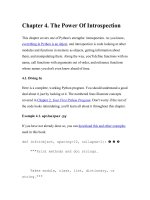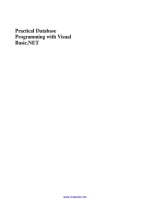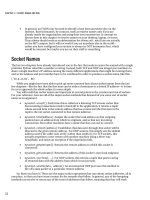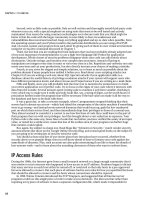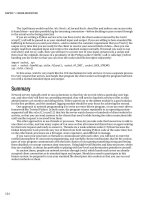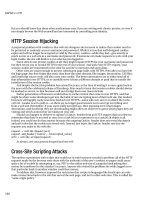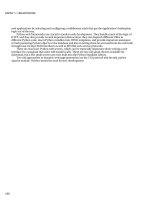Learning OpenCV 3 computer vision with python unleash the power of computer vision with python using OpenCV 2nd edition
Bạn đang xem bản rút gọn của tài liệu. Xem và tải ngay bản đầy đủ của tài liệu tại đây (4.41 MB, 266 trang )
[1]
Learning OpenCV 3 Computer
Vision with Python
Second Edition
Unleash the power of computer vision with Python
using OpenCV
Joe Minichino
Joseph Howse
BIRMINGHAM - MUMBAI
Learning OpenCV 3 Computer Vision with Python
Second Edition
Copyright © 2015 Packt Publishing
All rights reserved. No part of this book may be reproduced, stored in a retrieval
system, or transmitted in any form or by any means, without the prior written
permission of the publisher, except in the case of brief quotations embedded in
critical articles or reviews.
Every effort has been made in the preparation of this book to ensure the accuracy
of the information presented. However, the information contained in this book is
sold without warranty, either express or implied. Neither the authors, nor Packt
Publishing, and its dealers and distributors will be held liable for any damages
caused or alleged to be caused directly or indirectly by this book.
Packt Publishing has endeavored to provide trademark information about all of the
companies and products mentioned in this book by the appropriate use of capitals.
However, Packt Publishing cannot guarantee the accuracy of this information.
First published: September 2015
Production reference: 1240915
Published by Packt Publishing Ltd.
Livery Place
35 Livery Street
Birmingham B3 2PB, UK.
ISBN 978-1-78528-384-0
www.packtpub.com
Credits
Authors
Joe Minichino
Project Coordinator
Milton Dsouza
Joseph Howse
Proofreader
Reviewers
Safis Editing
Nandan Banerjee
Tian Cao
Brandon Castellano
Haojian Jin
Adrian Rosebrock
Commissioning Editor
Akram Hussain
Acquisition Editors
Vivek Anantharaman
Prachi Bisht
Content Development Editor
Ritika Singh
Technical Editors
Novina Kewalramani
Shivani Kiran Mistry
Copy Editor
Sonia Cheema
Indexer
Monica Ajmera Mehta
Graphics
Disha Haria
Production Coordinator
Arvindkumar Gupta
Cover Work
Arvindkumar Gupta
About the Authors
Joe Minichino is a computer vision engineer for Hoolux Medical by day and a
developer of the NoSQL database LokiJS by night. On weekends, he is a heavy metal
singer/songwriter. He is a passionate programmer who is immensely curious about
programming languages and technologies and constantly experiments with them. At
Hoolux, Joe leads the development of an Android computer vision-based advertising
platform for the medical industry.
Born and raised in Varese, Lombardy, Italy, and coming from a humanistic
background in philosophy (at Milan's Università Statale), Joe has spent his last
11 years living in Cork, Ireland, which is where he became a computer science
graduate at the Cork Institute of Technology.
I am immensely grateful to my partner, Rowena, for always
encouraging me, and also my two little daughters for inspiring
me. A big thank you to the collaborators and editors of this book,
especially Joe Howse, Adrian Roesbrock, Brandon Castellano, the
OpenCV community, and the people at Packt Publishing.
Joseph Howse lives in Canada. During the winters, he grows his beard, while
his four cats grow their thick coats of fur. He loves combing his cats every day and
sometimes, his cats also pull his beard.
He has been writing for Packt Publishing since 2012. His books include OpenCV for
Secret Agents, OpenCV Blueprints, Android Application Programming with OpenCV 3,
OpenCV Computer Vision with Python, and Python Game Programming by Example.
When he is not writing books or grooming his cats, he provides consulting,
training, and software development services through his company,
Nummist Media ().
About the Reviewers
Nandan Banerjee has a bachelor's degree in computer science and a master's
in robotics engineering. He started working with Samsung Electronics right after
graduation. He worked for a year at its R&D centre in Bangalore. He also worked in
the WPI-CMU team on the Boston Dynamics' robot, Atlas, for the DARPA Robotics
Challenge. He is currently working as a robotics software engineer in the technology
organization at iRobot Corporation. He is an embedded systems and robotics
enthusiast with an inclination toward computer vision and motion planning. He has
experience in various languages, including C, C++, Python, Java, and Delphi. He
also has a substantial experience in working with ROS, OpenRAVE, OpenCV, PCL,
OpenGL, CUDA and the Android SDK.
I would like to thank the author and publisher for coming out with
this wonderful book.
Tian Cao is pursuing his PhD in computer science at the University of North
Carolina in Chapel Hill, USA, and working on projects related to image analysis,
computer vision, and machine learning.
I dedicate this work to my parents and girlfriend.
Brandon Castellano is a student from Canada pursuing an MESc in electrical
engineering at the University of Western Ontario, City of London, Canada. He
received his BESc in the same subject in 2012. The focus of his research is in parallel
processing and GPGPU/FPGA optimization for real-time implementations of image
processing algorithms. Brandon also works for Eagle Vision Systems Inc., focusing
on the use of real-time image processing for robotics applications.
While he has been using OpenCV and C++ for more than 5 years, he has also been
advocating the use of Python frequently in his research, most notably, for its rapid
speed of development, allowing low-level interfacing with complex systems. This is
evident in his open source projects hosted on GitHub, for example, PySceneDetect,
which is mostly written in Python. In addition to image/video processing, he
has also worked on implementations of three-dimensional displays as well as the
software tools to support the development of such displays.
In addition to posting technical articles and tutorials on his website
(), he participates in a variety of both open and
closed source projects and contributes to GitHub under the username Breakthrough
( He is an active member of the Super
User and Stack Overflow communities (under the name Breakthrough), and can be
contacted directly via his website.
I would like to thank all my friends and family for their patience
during the past few years (especially my parents, Peter and Lori,
and my brother, Mitchell). I could not have accomplished everything
without their continued love and support. I can't ever thank
everyone enough.
I would also like to extend a special thanks to all of the developers
that contribute to open source software libraries, specifically
OpenCV, which help bring the development of cutting-edge
software technology closer to all the software developers around the
world, free of cost. I would also like to thank those people who help
write documentation, submit bug reports, and write tutorials/books
(especially the author of this book!). Their contributions are vital
to the success of any open source project, especially one that is as
extensive and complex as OpenCV.
Haojian Jin is a software engineer/researcher at Yahoo! Labs, Sunnyvale, CA. He
looks primarily at building new systems of what's possible on commodity mobile
devices (or with minimum hardware changes). To create things that don't exist
today, he spends large chunks of his time playing with signal processing, computer
vision, machine learning, and natural language processing and using them in
interesting ways. You can find more about him at />
Adrian Rosebrock is an author and blogger at />
He holds a PhD in computer science from the University of Maryland, Baltimore
County, USA, with a focus on computer vision and machine learning.
He has consulted for the National Cancer Institute to develop methods that
automatically predict breast cancer risk factors using breast histology images. He has
also authored a book, Practical Python and OpenCV ( on the
utilization of Python and OpenCV to build real-world computer vision applications.
www.PacktPub.com
Support files, eBooks, discount offers, and more
For support files and downloads related to your book, please visit www.PacktPub.com.
Did you know that Packt offers eBook versions of every book published, with PDF
and ePub files available? You can upgrade to the eBook version at www.PacktPub.com
and as a print book customer, you are entitled to a discount on the eBook copy. Get in
touch with us at for more details.
At www.PacktPub.com, you can also read a collection of free technical articles, sign
up for a range of free newsletters and receive exclusive discounts and offers on Packt
books and eBooks.
TM
/>
Do you need instant solutions to your IT questions? PacktLib is Packt's online digital
book library. Here, you can search, access, and read Packt's entire library of books.
Why subscribe?
• Fully searchable across every book published by Packt
• Copy and paste, print, and bookmark content
• On demand and accessible via a web browser
Free access for Packt account holders
If you have an account with Packt at www.PacktPub.com, you can use this to access
PacktLib today and view 9 entirely free books. Simply use your login credentials for
immediate access.
Table of Contents
Prefacevii
Chapter 1: Setting Up OpenCV
1
Choosing and using the right setup tools
Installation on Windows
Using binary installers (no support for depth cameras)
Using CMake and compilers
Installing on OS X
Using MacPorts with ready-made packages
Using MacPorts with your own custom packages
Using Homebrew with ready-made packages (no support for depth cameras)
Using Homebrew with your own custom packages
Installation on Ubuntu and its derivatives
Using the Ubuntu repository (no support for depth cameras)
Building OpenCV from a source
2
2
3
4
7
8
10
12
13
13
14
14
Installation on other Unix-like systems
15
Installing the Contrib modules
16
Running samples
16
Finding documentation, help, and updates
18
Summary19
Chapter 2: Handling Files, Cameras, and GUIs
Basic I/O scripts
Reading/writing an image file
Converting between an image and raw bytes
Accessing image data with numpy.array
Reading/writing a video file
Capturing camera frames
Displaying images in a window
Displaying camera frames in a window
Project Cameo (face tracking and image manipulation)
[i]
21
21
22
24
26
28
29
31
32
34
Table of Contents
Cameo – an object-oriented design
35
Abstracting a video stream with managers.CaptureManager
35
Abstracting a window and keyboard with managers.WindowManager
41
Applying everything with cameo.Cameo
42
Summary44
Chapter 3: Processing Images with OpenCV 3
45
Chapter 4: Depth Estimation and Segmentation
67
Chapter 5: Detecting and Recognizing Faces
89
Converting between different color spaces
45
A quick note on BGR
46
The Fourier Transform
46
High pass filter
47
Low pass filter
49
Creating modules
49
Edge detection
49
Custom kernels – getting convoluted
51
Modifying the application
53
Edge detection with Canny
55
Contour detection
56
Contours – bounding box, minimum area rectangle,
and minimum enclosing circle
57
Contours – convex contours and the Douglas-Peucker algorithm
60
Line and circle detection
62
Line detection
62
Circle detection
63
Detecting shapes
64
Summary65
Creating modules
Capturing frames from a depth camera
Creating a mask from a disparity map
Masking a copy operation
Depth estimation with a normal camera
Object segmentation using the Watershed and GrabCut algorithms
Example of foreground detection with GrabCut
Image segmentation with the Watershed algorithm
Summary
Conceptualizing Haar cascades
Getting Haar cascade data
Using OpenCV to perform face detection
Performing face detection on a still image
[ ii ]
67
68
71
72
74
80
82
84
87
90
91
91
92
Table of Contents
Performing face detection on a video
Performing face recognition
Generating the data for face recognition
Recognizing faces
Preparing the training data
Loading the data and recognizing faces
Performing an Eigenfaces recognition
Performing face recognition with Fisherfaces
Performing face recognition with LBPH
Discarding results with confidence score
94
97
98
100
101
102
103
105
106
106
Summary107
Chapter 6: Retrieving Images and Searching
Using Image Descriptors
Feature detection algorithms
Defining features
Detecting features – corners
109
109
110
110
Feature extraction and description using DoG and SIFT
113
Feature extraction and detection using Fast Hessian and SURF
ORB feature detection and feature matching
117
120
Feature matching with ORB
Using K-Nearest Neighbors matching
FLANN-based matching
FLANN matching with homography
A sample application – tattoo forensics
122
125
126
130
133
Anatomy of a keypoint
116
FAST120
BRIEF
121
Brute-Force matching
121
Saving image descriptors to file
Scanning for matches
133
134
Summary137
Chapter 7: Detecting and Recognizing Objects
Object detection and recognition techniques
HOG descriptors
The scale issue
The location issue
Non-maximum (or non-maxima) suppression
Support vector machines
People detection
Creating and training an object detector
139
139
140
142
142
145
146
147
149
Bag-of-words149
BOW in computer vision
150
Detecting cars
What did we just do?
153
155
[ iii ]
Table of Contents
SVM and sliding windows
160
Example – car detection in a scene
Dude, where's my car?
161
171
Summary175
Chapter 8: Tracking Objects
Detecting moving objects
Basic motion detection
Background subtractors – KNN, MOG2, and GMG
Meanshift and CAMShift
Color histograms
The calcHist function
The calcBackProject function
In summary
177
177
178
181
185
188
189
190
190
Back to the code
191
CAMShift193
The Kalman filter
194
Predict and update
195
An example
196
A real-life example – tracking pedestrians
199
The application workflow
A brief digression – functional versus object-oriented programming
The Pedestrian class
The main program
Where do we go from here?
200
200
202
205
207
Summary
Chapter 9: Neural Networks with OpenCV – an Introduction
Artificial neural networks
Neurons and perceptrons
The structure of an ANN
Network layers by example
The input layer
The output layer
The hidden layer
ANNs in OpenCV
ANN-imal classification
Training epochs
Handwritten digit recognition with ANNs
MNIST – the handwritten digit database
Customized training data
The initial parameters
The input layer
The hidden layer
The output layer
[ iv ]
208
209
209
210
211
212
212
212
212
214
216
220
222
222
222
222
222
223
223
Table of Contents
Training epochs
223
Other parameters
223
Mini-libraries224
The main file
228
Possible improvements and potential applications
234
Improvements234
Potential applications
235
Summary235
To boldly go…
235
Index237
[v]
Preface
OpenCV 3 is a state-of-the-art computer vision library that is used for a variety
of image and video processing operations. Some of the more spectacular and
futuristic features, such as face recognition or object tracking, are easily achievable
with OpenCV 3. Learning the basic concepts behind computer vision algorithms,
models, and OpenCV's API will enable the development of all sorts of real-world
applications, including security and surveillance tools.
Starting with basic image processing operations, this book will take you through
a journey that explores advanced computer vision concepts. Computer vision is a
rapidly evolving science whose applications in the real world are exploding, so this
book will appeal to computer vision novices as well as experts of the subject who
want to learn about the brand new OpenCV 3.0.0.
What this book covers
Chapter 1, Setting Up OpenCV, explains how to set up OpenCV 3 with Python on
different platforms. It will also troubleshoot common problems.
Chapter 2, Handling Files, Cameras, and GUIs, introduces OpenCV's I/O functionalities.
It will also discuss the concept of a project and the beginnings of an object-oriented
design for this project.
Chapter 3, Processing Images with OpenCV 3, presents some techniques required to
alter images, such as detecting skin tone in an image, sharpening an image, marking
contours of subjects, and detecting crosswalks using a line segment detector.
Chapter 4, Depth Estimation and Segmentation, shows you how to use data from a
depth camera to identify foreground and background regions, such that we can
limit an effect to only the foreground or background.
[ vii ]
Preface
Chapter 5, Detecting and Recognizing Faces, introduces some of OpenCV's face
detection functionalities, along with the data files that define particular types
of trackable objects.
Chapter 6, Retrieving Images and Searching Using Image Descriptors, shows how to
detect the features of an image with the help of OpenCV and make use of them
to match and search for images.
Chapter 7, Detecting and Recognizing Objects, introduces the concept of detecting and
recognizing objects, which is one of the most common challenges in computer vision.
Chapter 8, Tracking Objects, explores the vast topic of object tracking, which is the
process of locating a moving object in a movie or video feed with the help of a camera.
Chapter 9, Neural Networks with OpenCV – an Introduction, introduces you to Artificial
Neural Networks in OpenCV and illustrates their usage in a real-life application.
What you need for this book
You simply need a relatively recent computer, as the first chapter will guide
you through the installation of all the necessary software. A webcam is highly
recommended, but not necessary.
Who this book is for
This book is aimed at programmers with working knowledge of Python as well as
people who want to explore the topic of computer vision using the OpenCV library.
No previous experience of computer vision or OpenCV is required. Programming
experience is recommended.
Conventions
In this book, you will find a number of text styles that distinguish between different
kinds of information. Here are some examples of these styles and an explanation of
their meaning.
Code words in text, database table names, folder names, filenames, file extensions,
pathnames, dummy URLs, user input, and Twitter handles are shown as follows:
"We can include other contexts through the use of the include directive."
[ viii ]
Preface
A block of code is set as follows:
import cv2
import numpy as np
img = cv2.imread('images/chess_board.png')
gray = cv2.cvtColor(img, cv2.COLOR_BGR2GRAY)
gray = np.float32(gray)
dst = cv2.cornerHarris(gray, 2, 23, 0.04)
When we wish to draw your attention to a particular part of a code block, the
relevant lines or items are set in bold:
img = cv2.imread('images/chess_board.png')
gray = cv2.cvtColor(img, cv2.COLOR_BGR2GRAY)
gray = np.float32(gray)
dst = cv2.cornerHarris(gray, 2, 23, 0.04)
Any command-line input or output is written as follows:
mkdir build && cd build
cmake D
CMAKE_BUILD_TYPE=Release -DOPENCV_EXTRA_MODULES_PATH=
CMAKE_INSTALL_PREFIX=/usr/local ..
make
New terms and important words are shown in bold. Words that you see on the
screen, for example, in menus or dialog boxes, appear in the text like this: " On
Windows Vista / Windows 7 / Windows 8, click on the Start menu."
Warnings or important notes appear in a box like this.
Tips and tricks appear like this.
[ ix ]
Preface
Reader feedback
Feedback from our readers is always welcome. Let us know what you think about
this book—what you liked or disliked. Reader feedback is important for us as it helps
us develop titles that you will really get the most out of.
To send us general feedback, simply e-mail , and mention
the book's title in the subject of your message.
If there is a topic that you have expertise in and you are interested in either writing
or contributing to a book, see our author guide at www.packtpub.com/authors.
Customer support
Now that you are the proud owner of a Packt book, we have a number of things to
help you to get the most from your purchase.
Downloading the example code
You can download the example code files from your account at http://www.
packtpub.com for all the Packt Publishing books you have purchased. If you
purchased this book elsewhere, you can visit />and register to have the files e-mailed directly to you.
Errata
Although we have taken every care to ensure the accuracy of our content, mistakes
do happen. If you find a mistake in one of our books—maybe a mistake in the text or
the code—we would be grateful if you could report this to us. By doing so, you can
save other readers from frustration and help us improve subsequent versions of this
book. If you find any errata, please report them by visiting ktpub.
com/submit-errata, selecting your book, clicking on the Errata Submission Form
link, and entering the details of your errata. Once your errata are verified, your
submission will be accepted and the errata will be uploaded to our website or added
to any list of existing errata under the Errata section of that title.
To view the previously submitted errata, go to />content/support and enter the name of the book in the search field. The required
information will appear under the Errata section.
[x]
Preface
Piracy
Piracy of copyrighted material on the Internet is an ongoing problem across all
media. At Packt, we take the protection of our copyright and licenses very seriously.
If you come across any illegal copies of our works in any form on the Internet, please
provide us with the location address or website name immediately so that we can
pursue a remedy.
Please contact us at with a link to the suspected
pirated material.
We appreciate your help in protecting our authors and our ability to bring you
valuable content.
Questions
If you have a problem with any aspect of this book, you can contact us at
, and we will do our best to address the problem.
[ xi ]
Setting Up OpenCV
You picked up this book so you may already have an idea of what OpenCV is.
Maybe, you heard of Sci-Fi-sounding features, such as face detection, and got
intrigued. If this is the case, you've made the perfect choice. OpenCV stands for
Open Source Computer Vision. It is a free computer vision library that allows you
to manipulate images and videos to accomplish a variety of tasks from displaying
the feed of a webcam to potentially teaching a robot to recognize real-life objects.
In this book, you will learn to leverage the immense potential of OpenCV with the
Python programming language. Python is an elegant language with a relatively
shallow learning curve and very powerful features. This chapter is a quick guide to
setting up Python 2.7, OpenCV, and other related libraries. After setup, we also look
at OpenCV's Python sample scripts and documentation.
If you wish to skip the installation process and jump right into action,
you can download the virtual machine (VM) I've made available at
/>This file is compatible with VirtualBox, a free-to-use virtualization
application that lets you build and run VMs. The VM I've built is
based on Ubuntu Linux 14.04 and has all the necessary software
installed so that you can start coding right away.
This VM requires at least 2 GB of RAM to run smoothly, so make sure
that you allocate at least 2 (but, ideally, more than 4) GB of RAM to
the VM, which means that your host machine will need at least 6 GB
of RAM to sustain it.
[1]
Setting Up OpenCV
The following related libraries are covered in this chapter:
• NumPy: This library is a dependency of OpenCV's Python bindings.
It provides numeric computing functionality, including efficient arrays.
• SciPy: This library is a scientific computing library that is closely related to
NumPy. It is not required by OpenCV, but it is useful for manipulating data
in OpenCV images.
• OpenNI: This library is an optional dependency of OpenCV. It adds the
support for certain depth cameras, such as Asus XtionPRO.
• SensorKinect: This library is an OpenNI plugin and optional dependency of
OpenCV. It adds support for the Microsoft Kinect depth camera.
For this book's purposes, OpenNI and SensorKinect can be considered optional.
They are used throughout Chapter 4, Depth Estimation and Segmentation, but are
not used in the other chapters or appendices.
This book focuses on OpenCV 3, the new major release of the
OpenCV library. All additional information about OpenCV is
available at , and its documentation is
available at />
Choosing and using the right setup tools
We are free to choose various setup tools, depending on our operating system and
how much configuration we want to do. Let's take an overview of the tools for
Windows, Mac, Ubuntu, and other Unix-like systems.
Installation on Windows
Windows does not come with Python preinstalled. However, installation wizards are
available for precompiled Python, NumPy, SciPy, and OpenCV. Alternatively, we
can build from a source. OpenCV's build system uses CMake for configuration and
either Visual Studio or MinGW for compilation.
If we want support for depth cameras, including Kinect, we should first install
OpenNI and SensorKinect, which are available as precompiled binaries with
installation wizards. Then, we must build OpenCV from a source.
The precompiled version of OpenCV does not offer support
for depth cameras.
[2]
Chapter 1
On Windows, OpenCV 2 offers better support for 32-bit Python than 64-bit Python;
however, with the majority of computers sold today being 64-bit systems, our
instructions will refer to 64-bit. All installers have 32-bit versions available from the
same site as the 64-bit.
Some of the following steps refer to editing the system's PATH variable. This task can
be done in the Environment Variables window of Control Panel.
1. On Windows Vista / Windows 7 / Windows 8, click on the Start menu and
launch Control Panel. Now, navigate to System and Security | System |
Advanced system settings. Click on the Environment Variables… button.
2. On Windows XP, click on the Start menu and navigate to Control Panel |
System. Select the Advanced tab. Click on the Environment Variables…
button.
3. Now, under System variables, select Path and click on the Edit… button.
4. Make changes as directed.
5. To apply the changes, click on all the OK buttons (until we are back in the
main window of Control Panel).
6. Then, log out and log back in (alternatively, reboot).
Using binary installers (no support for depth
cameras)
You can choose to install Python and its related libraries separately if you prefer;
however, there are Python distributions that come with installers that will set up the
entire SciPy stack (which includes Python and NumPy), which make it very trivial to
set up the development environment.
One such distribution is Anaconda Python (downloadable at
http://09c8d0b2229f813c1b93c95ac804525aac4b6dba79b00b39d1d3.r79.
cf1.rackcdn.com/Anaconda-2.1.0Windows-x86_64.exe). Once the installer is
downloaded, run it and remember to add the path to the Anaconda installation to
your PATH variable following the preceding procedure.
[3]
Setting Up OpenCV
Here are the steps to set up Python7, NumPy, SciPy, and OpenCV:
1. Download and install the 32-bit Python 2.7.9 from hon.
org/ftp/python/2.7.9/python-2.7.9.amd64.msi.
2. Download and install NumPy 1.6.2 from .
edu/~gohlke/pythonlibs/#numpy />numpy/files/NumPy/1.6.2/numpy-1.6.2-win32-superpackpython2.7.exe/download (note that installing NumPy on Windows 64-bit
is a bit tricky due to the lack of a 64-bit Fortran compiler on Windows, which
NumPy depends on. The binary at the preceding link is unofficial).
3. Download and install SciPy 11.0 from />
pythonlibs/#scipy />scipy/0.11.0/scipy-0.11.0win32-superpack-python2.7.exe/download
(this is the same as NumPy and these are community installers).
4. Download the self-extracting ZIP of OpenCV 3.0.0 from https://github.
com/Itseez/opencv. Run this ZIP, and when prompted, enter a destination
folder, which we will refer to as <unzip_destination>. A subfolder,
<unzip_destination>\opencv, is created.
5. Copy <unzip_destination>\opencv\build\python\2.7\cv2.pyd to C:\
Python2.7\Lib\site-packages (assuming that we had installed Python 2.7
to the default location). If you installed Python 2.7 with Anaconda, use the
Anaconda installation folder instead of the default Python installation. Now,
the new Python installation can find OpenCV.
6. A final step is necessary if we want Python scripts to run using the new
Python installation by default. Edit the system's PATH variable and append
;C:\Python2.7 (assuming that we had installed Python 2.7 to the default
location) or your Anaconda installation folder. Remove any previous Python
paths, such as ;C:\Python2.6. Log out and log back in (alternatively, reboot).
Using CMake and compilers
Windows does not come with any compilers or CMake. We need to install them.
If we want support for depth cameras, including Kinect, we also need to install
OpenNI and SensorKinect.
[4]
